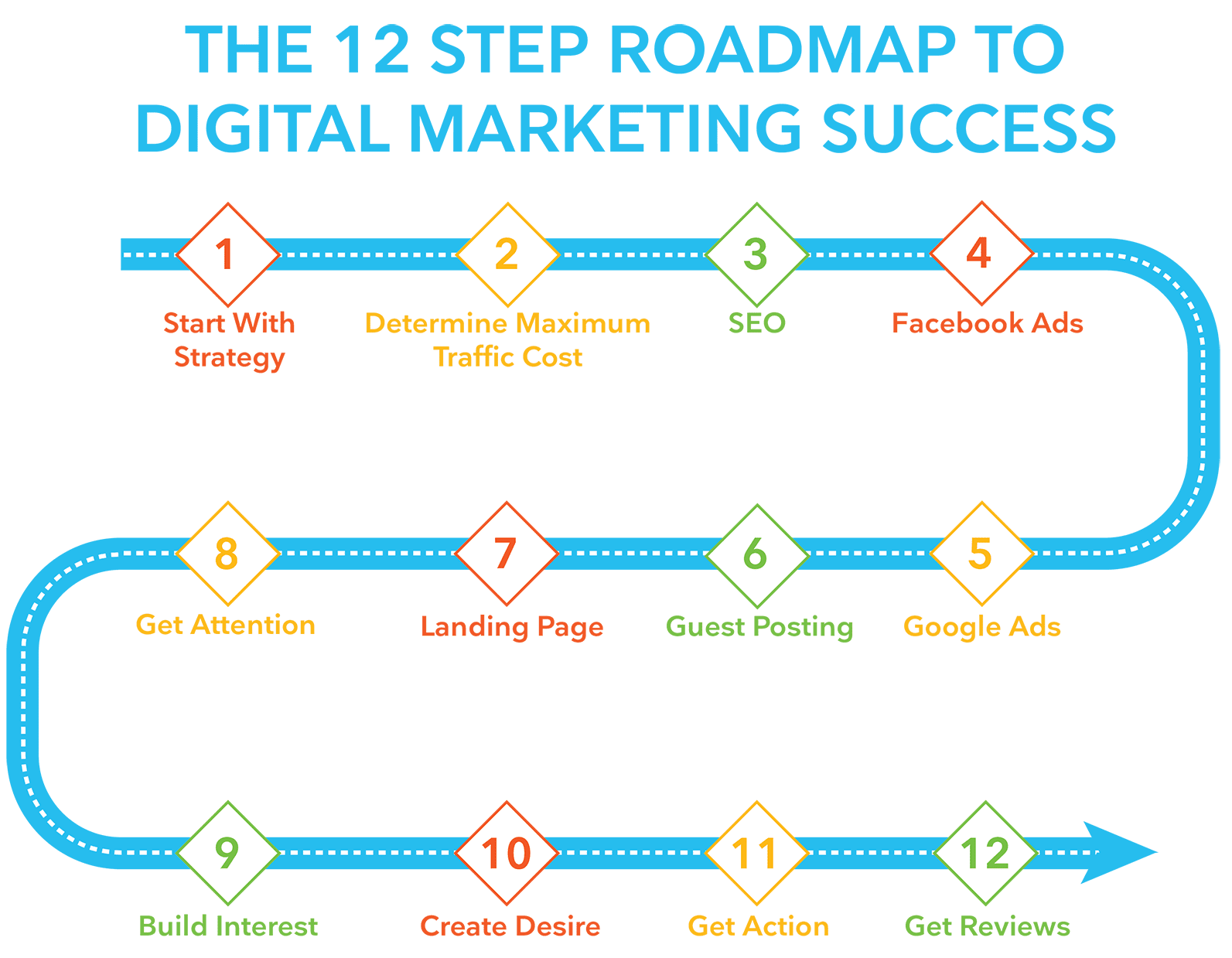The Digital Marketing Roadmap: 12 Steps to Success

What is a Digital Marketing Roadmap?
Your success comes down to two major things:
- driving enough traffic and
- converting that traffic.
However, few people know how to drive enough traffic and even fewer know what to do with it once they have it.
Avoid the mistake of not having the right knowledge and instead educate yourself on the proven and powerful methods to generate leads, views, downloads, sales, and subscriptions.
1. Start With Strategy
You may be able to successfully generate traffic to an existing website, but it won’t help if the site fails to convert. A digital marketing strategy is critical to your business’ success. Your website must be mobile-friendly and modern with a great UI and UX to bring customers into the business. Many businesses have beautiful websites, but they focus too heavily on being cute and not enough on user experience, sales and conversions.
There’s a parable of a young man who is aimlessly lost in the woods. After being lost for days, he is tired and hungry and afraid. Eventually, after stumbling along a bit longer, he comes across an old sage by a small pond. The young man asks the old sage which way he should go. The sage asks him where he is trying to go, to which the young man responds “I don’t know.” The old man then said, “Well then it doesn’t much matter which way you go, does it?”
The moral of the story is that you can’t achieve success if you haven’t defined it yet. That’s why knowing your conversion goal is key to understanding which traffic source will be best for you. That’s where the math comes in:
2. Determine Your MTC
Before you start driving traffic, you must determine your MTC (Maximum Traffic Cost). This number is the most you can spend on driving traffic to still make a profit. To determine this, you need a few things: the profit per unit sold and the conversion rate.
Using these two numbers will yield the cost per conversion or cost per acquisition (CPA). This is the amount it costs you to make one sale. If this number is higher than the profit generated from one sale, you’re in trouble. If the number is lower, then you’re in business. It means you can continue to pay for traffic and maintain profitability.
For example, imagine that you sell a product for $100 each at a $50 profit. If it costs you $250 to drive 1,000 visitors to your site and you convert one out of ten visitors (10%), then you would generate 100 sales for a profit of $5,000. That’s a return of 20x on your investment. Numbers like this are possible, but you have to use the right traffic source for you.
3. SEO
SEO (Search Engine Optimization) is one of the most common marketing strategies. It has been around for a while, but it has changed significantly. You may have heard that SEO is all about “keyword stuffing.” While this was a practice for many years, Google’s algorithms have gotten smarter.
Today, you can drive traffic to your blog by using quality keywords three to four times within a larger article. Aim for 1000 words or more. Don’t try to spam words. Instead, make the content useful and engaging. If you do that, you’ll find visitors coming back for more and it will make your job of converting them a lot easier.
4. Facebook Ads
Just a few short years ago, Facebook was a platform that teens used to get away from their parents. It was similar to what Snapchat is now. Because of its initial use as a social platform for young people (and the relative lack of familiarity of social networks in general back then) businesses dismissed it as an advertising platform.
Having that same attitude about Facebook today would be a giant mistake. Facebook boasts billions of users and has grown to become a robust platform for marketers in every industry. Facebook Ads can be targeted to very specific demographics, allowing you to handpick who you want to show your marketing to and who you don’t (allowing you to avoid wasting dollars on non-buyers).
5. Google Ads
While Facebook is powerful in that it reaches a large demographic and you can create a very specific target audience, Google has another thing working for it: purchase intent. When someone sees your ad on Facebook, they’re likely just browsing photos of friends and family.
With Google Ads, they’re seeing paid ads show up specifically related to whatever they are searching for in real-time. If someone sees a paid ad for “baseball caps” it’s because they already wanted it: they are farther along in the sales cycle. Use Google Ads for products or services that are more time-sensitive: car repairs, home services, and babysitting are all examples of businesses that can enjoy relevant traffic through Google.
6. Guest Posting
Don’t underestimate the power of the guest post. This simply involves writing an article or blog post and teaming up with a non-competitive business in a related field to link back to your site. In essence, you’re piggybacking on the trust that readers have for the person’s blog you’re posting on, and hoping that a sufficient amount of traffic comes through as a result.
7. Landing Page
Once you’ve chosen a traffic method above, it’s time to get your landing page prepared. This is simply the webpage that you are sending your traffic to. It’s essential that your landing page does several things to guide visitors along the sales process and lead to your ultimate conversion: a sale.
Here are the 4 stages of a great landing page:
- Get Attention
- Build Interest
- Create Desire
- Get Action
8. Get Attention
The first step to any great on-page sales funnel is your attention-getting devices. These include your headline and images. Your headline must grab the attention of the reader so much that they virtually stop in their tracks and want to read more. Use compelling offers and provocative questions. For instance, “Why haven’t doctors told you these facts about weight loss?” evokes curiosity and is much better than “Neat facts about losing weight.”
Also, notice how the headline above offers a primary benefit (losing weight) right away. Don’t wait until half-way down your landing page to mention what you can do for people. If you can’t outright say it without scaring your market off, then at least hint at the problem to be solved so you can present your solution later on.
9. Build Interest
Once you’ve gotten attention, you’ve passed the first test. There’s a lot to be said for getting a visitor to click on your ad (or article in Google’s search results) and coming to your page in the first place. Furthermore, getting them to read the headline and think “that’s relevant, I’ll read the article” is great. But don’t pat yourself on the back just yet. You still need to build more interest in the prospect.
You can do this by focusing in on the problems that they have. Be careful about boasting. Don’t talk about your company the whole time, as it comes off as not being interested in your customer. Talk about them: their needs, goals, and problems. Everyone’s favorite subject is themselves (even if they don’t want to admit it).
10. Create Desire
Desire is the next step in the ultimate digital marketing agency plan. Sure, you’ve built some interest, but desire is different. To truly build desire is to make your visitor so emotionally primed that they virtually can’t wait until you make your offer to purchase. Without desire, you will never get the sale. Don’t think you can take a shortcut. This goes for technical sales as well.
Just because the product is “boring” doesn’t mean that the consequences of taking action or not taking action are boring. Your customer has real-life problems and your product affects them at a deep level. Help them understand this through powerful storytelling and visual descriptions. Make them feel as if they already own what you’re selling. Doing this will help you achieve the feeling of desire necessary for the next step to be successful:
11. Get Action
Many times, a simple “buy now” or “get started” will be enough to get the prospect to convert to a paying customer or loyal subscriber. However, there are times when this isn’t enough.
If you find that your conversions are not as high as you would like them, you can introduce mechanisms that improve your odds of making conversions on the first visit.
The first one is social proof: use testimonials or reviews of happy customers to raise the buyer’s confidence level in their decision.
Secondly, put an expiration date on the offer. Whether it’s this weekend or within 24 hours, mention that the special price they see today will not be here forever.
And finally, be sure to point out what they are missing out on if they don’t pull the trigger. Many people think about the cost of your product, but don’t let them lose sight of the cost of not having your product.
12. Get Reviews
90% of consumers read online reviews before visiting a business. If you have too many negative reviews or no reviews you should expect your business to fail.
Online reviews are more important today than ever to brands, businesses, products and services. Customers search for your brand on the go and make a quick decision about if they want to do business with you.
Consumer feedback is significantly important to all businesses. Getting reviews and feedback from customers will improve your company’s operations and provide insight for delivering better products and better overall customer experience.
Take Your Digital Marketing Efforts to the Next Level
When it comes to digital marketing, driving traffic and getting conversions online, it can be a minefield. Luckily, with the right digital marketing agency it doesn’t have to be.
If you use the tactics above, you can enjoy more visitors and sales than ever before. But don’t hesitate to put these tips into action. Get one step ahead of the competition so you can have more market share and less headache.
You can have the best product in the world, but if you don’t have any customers that see it, it won’t matter because it’s impossible to make a sale.
Traffic solves this problem. It directs visitors to your landing page so they can discover your brand or your particular offer. Without traffic, you have no leads and no conversions. So how do you go about generating traffic?
The reality is that there are a handful of powerful ways to get people to your site. Some are free, some are expensive, some are fast, and some are slow. Work with M16 Marketing® to find the right digital marketing strategy.










